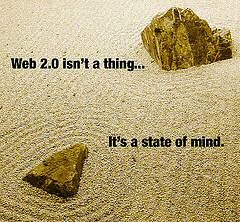(Photo by Daniel F. Pigatto)
I was in two minds on whether to get involved with this debate/discussion, but since we now seem to have accepted “Enterprise 2.0” into the social computing lexicon I thought I should at least ensure I’ve got a clear understanding about what this means.The authors over at Library Clips have identified seven ways that Enterprise 2.0 differs from Web 2.0. This article is in turn based on the blog by Bill Ives at Fast Forward blog. To summarise what is quite a lengthy diatribe, the seven differences between E2 and W2 come down to:
- Enterprise 2.0 is more about project work whereas Web2.0 is more about purpose based sharing and learning.
- Enterprise 2.0 means being accountable to someone other than yourself.
- The choice of tools (applications) are mandated in Enterprise 2.0
- Facilitation techniques are more appropriate to Enterprise 2.0 where people need to be encouraged and guided in knowledge sharing, whereas Web 2.0 has no agenda.
- Enterprise 2.0 does not have the critical mass of the network effect (long tail).
- Transparency – Enterprise 2.0 is not an egalitarian culture like the open web; it has managers and hierarchies.
- Productivity is not measured in Web 2.0
My apologies to the authors if my synoptic presentation of the seven differences does not capture the entire context, but I’m trying to distil some fairly complex ideas into something most people can understand and relate to.At this point I should make clear that I personally find this preoccupation with categorising and defining behaviours so that we can apply some suitable marketing labels to them (which sadly is what Web 2.0 and Enterprise 2.0 have become) a rather frivolous activity. However, I accept it is important to some people (and particularly product vendors), and as a professional in this area myself, I need to ensure I’m using these labels in the right context when I’m having conversations with my clients or peers.From my own experience – drawn primarily from the development and support of Communities of Practice (CoPs) in the public sector, and deploying social networking and social media tools to facilitate connections and knowledge sharing – I have tended to think of Web 2.0 more as an enabling technology that can release the inherent creativity and desire to socialise that exists in most of the human species. If I tried to apply the Web 2.0/Enterprise 2.0 definitions to the public sector CoP platform, I wouldn’t be able to find any Community of Practice that could be neatly pigeon-holed. Some are working on projects, some are learning communities. Some have management inspired objectives, some maintain hierarchies. Some are facilitated and some are just self-organising groups (yes I know – not strictly a definition of a CoP). None of them are mandated to use the tools. So, whether I’ve created a Web 2.0 or an Enterprise 2.0 environment I really don’t know, and don’t really care because it doesn’t make an iota of difference to the fact that the environment enables people to find and share knowledge, to collaborate with experts and peers and encourages innovation.So, whilst I’ll accept the definitions or differences between Web 2.0 and Enterprise 2.0 – all of which seem to be reasonably well thought through – the priority for me is encouraging, supporting and coaching the behaviours that will enable people to make the most of these technologies – regardless of what labels they are given!
